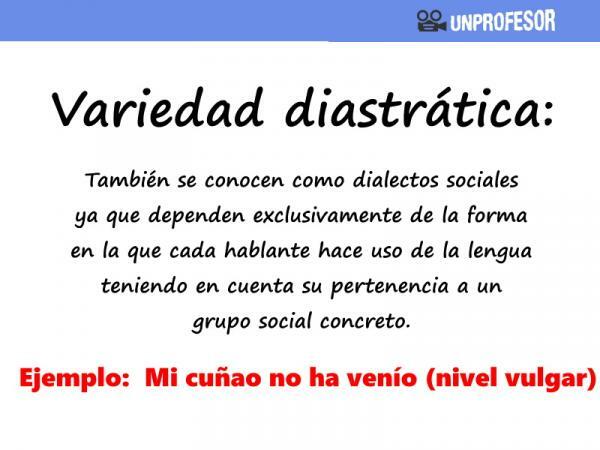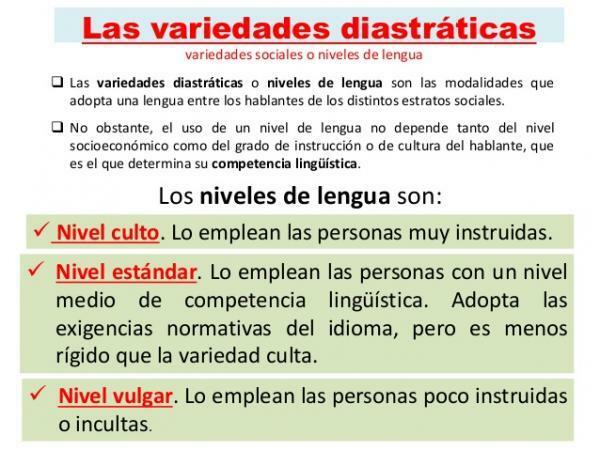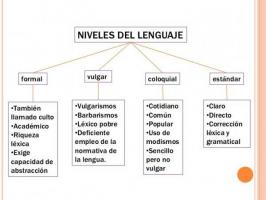DIASTRÁTIC variety: characteristics and examples

The Spanish language has different variants that make it not static. In this lesson from a TEACHER, we want to continue expanding the subject on these variants and we want to show you what diastratic variety, their features and examples so that you know how to distinguish it from others such as the diatopic variety we have already talked about. Next, through its peculiarities and examples, we show you how you can identify it.
Although the most common is the use of a standard language with which all speakers can communicate, the truth is that there is a diastratic variety that makes there different levels or different ways the language is used. In other words, varieties of this type will have to do with the way in which each group of speakers makes use of it depending on the social group to which it belongs.
The tongue may present different varieties attending to different criteria. In the present case, we are going to focus on the variety that occurs when we look at the the speaker's membership in a specific social or educational group
. This variety is what represents, in the form of language, the social, economic and educational position of the person who is speaking. In addition to the aforementioned factors, the use of the different levels of the language will also depend on the age of the speakers or the profession, among others.These diastratic varieties are also known as social dialects since they depend solely and exclusively on the way in which each speaker makes use of the language, taking into account its belonging to a specific social group.
The key factor to highlight within the diastratic variety of language is the speaker's cultural level. Within our society we can distinguish different groups either by age or relationship. This will determine the level of language used. To be able to understand it more easily, imagine the following situation:
You are at the university and you must write a paper to deliver to your professor. This work must be correct in every way, so you must use the appropriate language and syntax so that it can be understood. Imagine now that this same work must be published in a scientific journal, in this case, the level of language, due to the scope of publication of the text, will be different.
Therefore and taking into account the above we can indicate that the Spanish language can be divided into three different diastratic levels or varieties:
- Cult level
- Standard level
- Vulgar level

In order for you to better understand this linguistic variety, below we are going to offer you a summary of the characteristics of diastratic and, thus, you will understand this concept better.
Characteristics of the cultured level
It is the highest level that exists and is related to a high cultural and educational level. It is often used by educated people and is used when we want to establish communication aimed at academic or scientists. Among its characteristics we can highlight:
- Correction: it is a use of structured, rigid and precise language that seeks correction in all its areas, that is, in a lexical, morphosyntactic and phonetic way.
- Language: it is precise and has a great linguistic variety. The lexicon used at the cultured level has a multitude of cultisms and rich synonyms that add value to the text.
- Syntax: this level of the language seeks correction in a written way through complex structures in which different verb tenses are used with mastery. Long, complex and compound sentences are used in which different links and complements intervene. On the other hand, in its spoken facet, it seeks to establish a correct use of the pronunciation of each of the words.
- Abstraction: they make a very abundant use of concepts of abstract type.
- Invariable: This is a level that is not very supportive of changes. It is conservative and traditional in terms of its written and oral form.
Standard level features
Is the most extended in all areas of society. That is to say, standard Spanish is the most widely used since it is at the intermediate level and makes use of the norms of linguistics and grammar of the language, but a series of licenses are allowed that make it less rigid and traditional than the worship.
It's used both in written and oral communication and it is used in different social and cultural settings, for example, this type of level of Spanish will be used in the media or in education. Because it is less rigid, it is open to the inclusion of changes and variations brought about by use or by fashion.
Characteristics of the vulgar level
It is associated with a lower cultural and educational level. Its characteristics include the incorrect use of language in which there are a multitude of linguistic and grammatical errors. It has a very simple grammar and a language with little variety, in addition to being repetitive and with frequent use of vulgarisms.

Image: Slideplayer
Next we are going to show you a series of examples of each of the varieties that we have shown you previously. In this way you can easily identify each of them and know how and when they are used:
- Cult level: The analysis variables applied to the object of study of this research, make us let us hypothesize that the subject is suspected of belonging to an unidentified subgroup in the present.
- Standard level: Last November the Government communicated, through a press conference, what will be its roadmap for the next legislature.
- Vulgar level: My brother-in-law has not come, he tells me that his brother-in-law is at home.
We hope that thanks to this lesson on the diastratic variety, its characteristics and examples, you have been able to understand what it is and how it is used. If you want to continue learning, be sure to visit our section on Spanish language in which you will find a multitude of very interesting articles.



